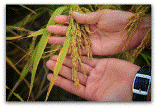Plant Pathology, Department of

Fungal Molecular Plant-Microbe Interactions
Date of this Version
2009
Document Type
Article
Citation
Microbiology (2009) 155: 3,810–3,815
doi: 10.1099/mic.0.035436-0
Abstract
The study of fungal physiology is set to change dramatically in the next few years as highly scalable technologies are deployed allowing accurate measurement and identification of metabolites, proteins and transcripts within cells. The advent of next-generation DNA-sequencing technologies will also provide genome sequence information from large numbers of industrially relevant and pathogenic fungal species, and allow comparative genome analysis between strains and populations of fungi. When coupled with advances in gene functional analysis, protein-protein interaction studies, live cell imaging and mathematical modelling, this promises a step-change in our understanding of how fungal cells operate as integrated dynamic living systems


Comments
Copyright 2009, Society for General Microbiology. Used by permission.